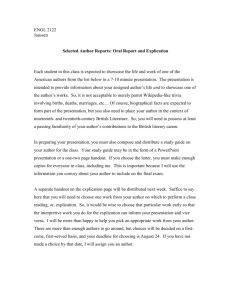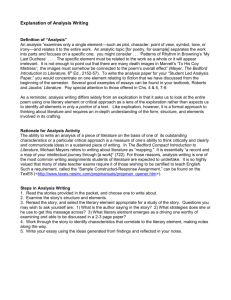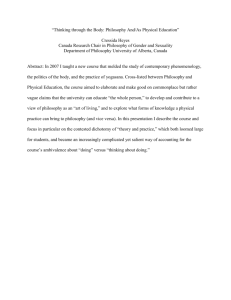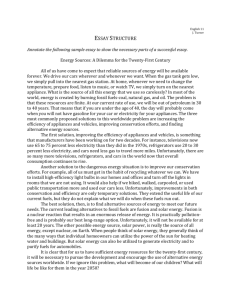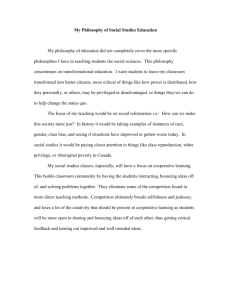Explication of focal concepts and principles in science
advertisement
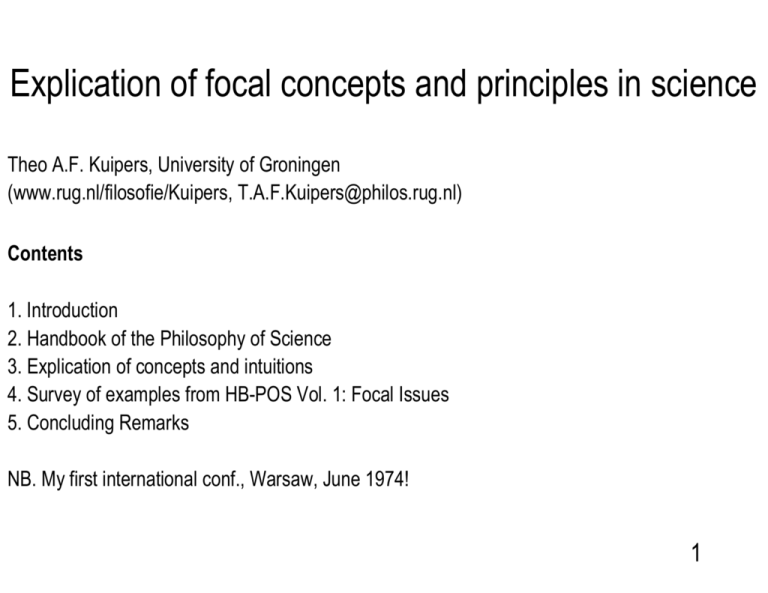
Explication of focal concepts and principles in science Theo A.F. Kuipers, University of Groningen (www.rug.nl/filosofie/Kuipers, T.A.F.Kuipers@philos.rug.nl) Contents 1. Introduction 2. Handbook of the Philosophy of Science 3. Explication of concepts and intuitions 4. Survey of examples from HB-POS Vol. 1: Focal Issues 5. Concluding Remarks NB. My first international conf., Warsaw, June 1974! 1 1. Introduction • Scientists use subject specific concepts and principles, as well as concepts, principles and intuitions that they share with colleagues working in different fields • Cf. 'the valence of an atom' resp. 'confirmation of a hypothesis by evidence' • Task of 'philosophy of (the special science of) chemistry': rational reconstruction or explication of the concept of 'valence' • Task 'general philosophy of science': explication of the concept of 'confirmation' 2 Introduction, cont. • Evident: philosophers should do justice, as much as possible, to the uses of these notions by scientists, however, without being the slave of them. That is, occasionally there may be good reasons for proposing scientists to deviate from a standard practice • Explication not only of concepts but also of principles and intuitions of scientists • E.G. 'conservation of energy'-principle, resp. intuition 'diminishing returns from repeated tests' • Both aren't crystally clear, they need explication 3 2. Handbook of the Philosophy of Science (Elsevier) Series editors: Dov Gabbay, Paul Thagard, and John Woods • In the general volume (Focal Issues) of the upcoming Handbook of the Philosophy of Science focal issues of a general nature are dealt with, whereas in the 15 special volumes discipline specific issues are at issue • In both cases, several contributions illustrate, although largely implicit, that there is at least one widely used method in philosophy of science, the method of explication 4 Planned volumes (* in production)+ volume editors 1. Philosophy of Science, Focal Issues 2. Philosophy of Physics* 3. Philosophy of Biology 4. Philosophy of Mathematics 5. Philosophy of Logic* 6. Philosophy of Chemistry and Pharmacy 7. Philosophy of Statistics 8. Philosophy of Information T.Kuipers J. Earman & J. Butterfield M.Matthen & C.Stephens A. Irvine D. Jacquette A. Woody & R. Hendry M. Forster P.Adriaans&JvBenthem 5 Continued 9. Philosophy of Tchnological Sciences A.Meijers 10. Philosophy of Complex Systems C.Hooker & J.Collier 11. Philosophy of Earth Science B. Brown & K.Peacock 12. Philosophy of Psychology and Cognitive Science* P.Thagard 13. Philosophy of Economics U. Mäki 14. Philosophy of Linguistics M. Stokhof&J.Groenendijk 15. Philosophy of Anthropology and Sociology* S.Turner & M..Risjord 16. Philosophy of Medicine F.Gifford 6 T.O.C. Vol.1: Philosophy of Science. Focal Issues. 0. 1. 2. 3. 4. Introduction. The method of explication Laws, Theories and Research Programs Past and Contemporary Perspectives on Explanation Evaluation of Theories The Role of Experiments in the Natural Sciences. Examples from Physics and Biology 5. The Role of Experiments in the Social Sciences. The Case of Economics 6. Ontological, Epistemological, and Methodological Positions 7. Reduction, Integration, and the Unity of Science: Natural, Behavioural, and Social Sciences and the Humanities 8. Logical, Historical and Computational Approaches 9. Demarcating Science from Nonscience 10. History of the Philosophy of Science Theo A.F. Kuipers Theo A.F. Kuipers Stathis Psillos Ilkka Niiniluoto Allan Franklin Wenceslao J. Gonzalez James Ladyman William Bechtel & Andrew Hamilton Atocha Aliseda & Donald Gillies Martin Mahner Friedrich Stadler 7 3. Explication of concepts and intuitions: a meta-explication 3.1. Basic ideas In the spirit of Rudolf Carnap (1950), Carl Hempel (1952), John Kemeny and Paul Oppenheim (1952) + 'progress in concept explication' + special strategy (I&C) Point of departure: an informal concept, the explicandum, • • • Aim: define a concept, the explicatum, satisfying three general desiderata: preciseness, fruitfulness and simplicity and being similar to the informal concept 8 Similarity with the informal concept to be evaluated by two kinds of specific desiderata: • The explicatum should apply to evident, undisputed (types of) examples of the informal concept and not to evident, undisputed (types of) non-examples • The explicatum should fulfil (specific desiderata or) conditions of adequacy derived from the informal concept, and occasionally violate conditions of inadequacy NB.1 evident (non-)examples may be generalizable to a condition of (in)adequacy NB.2 explication is active enterprise, as opposed to concept or meaning analysis; however, also useful, if only for searching evident (non-)examples and conditions of (in)adequacy 9 Example 1: 'confirmation’ Up to a first, partial explication Hypothesis: "all ravens are black” - evident non-example, even counterexample: a white raven - evident example, at least prima facie, a black raven This may be generalized to a condition of adequacy: - CA1: positive instances confirm a generalization Even more general: Principle of Confirmation or Weak Principle of Induction: positive instances of a hypothesis support the claim that the hypothesis is true - evident non-example: a black non-raven, e.g. a black tie But what about a non-black non-raven, e.g. a red tie? 10 Hempel’s ‘paradox’ Suppose also: - CA2: 'equivalence condition', that is, if certain evidence confirms a certain hypothesis then it confirms any of its equivalent versions Consequence of CA1 and CA2: a non-black non-raven, e.g. a red tie, also confirms “all ravens are black”, for that hypothesis is logically equivalent to "all non-black objects are non-ravens” 3 options: accept consequence or start to dispute CA1 or CA2. If solved, how to extend? 11 Further conditions of (in-)adequacy - CA3: 'consequence condition’: if certain evidence confirms a certain hypothesis then it confirms any of its consequences - CA4: 'converse consequence condition', if certain evidence confirms a certain hypothesis then it confirms any stronger one Two opposing conditions, both with some intuitive appeal, but combined they lead to absurd conclusions, notably, any evidence confirms any hypothesis as soon as it confirms some 12 One partial explication Conditional deductive (cd-)confirmation, defined as: E deductively confirms H on condition C if H&C |= E and …(some technical conditions) treats all (non-)examples correctly, accepts, on purpose, red ties, and satisfies CA1, 2, 4, but violates, on purpose, CA3 For further motivation + state of the art (Kuipers, 2000, Chs 2-4): several confirmation languages, 'confirmation language games', partial or complete, qualitative or probabilistic ones, inductive or non-inductive 13 3.2. Evaluation report of a (proposed) explication Answers the question to what extent the proposed explicatum satisfies the general and the specific desiderata: • General desiderata, recall: Preciseness, Fruitfulness, Simplicity. Informal scoring, comparative scoring (below) more important than separate scoring • Specific desiderata: plausible to use problem solving terminology of successes and problems (Kuhn, Laudan) 14 Evaluation report wrt specific desiderata Successes Evident examples Evident nonexamples Conditions of adequacy Conditions of inadequacy Grey area Problems True positives False negatives True negatives False positives If satisfied If violated If violated If satisfied 15 False positives show that the explication is too wide and false negatives that it is too narrow. Similarly, violated conditions of adequacy show that the explication is too wide and fulfilled conditions of inadequacy that the explication is too narrow Questioned cases may lead to connotation revision or, when the disputed case results from an idealized or naïve point of departure, ask for refinement or concretization of the proposal (examples below) One of these reactions may also apply to evident problems 16 Conditions of adequacy for concept explication in general may be of a formal or an empirical nature, resulting from a previous meaning analysis or from a previous empirical analysis, respectively (Hempel, 1952) Empirical CA: example: Einstein, simultaneity, guided by "velocity of light is constant in all frames of reference" Formal conditions of adequacy may be of a justificatory nature, for example, in the sense that the explication should provide some required existence and uniqueness conditions. They may also pertain to the intended justification of a certain intuition or dissolving a paradox 17 18 3.3. Progress in concept explication • Concept explication frequently leads to branching • If two proposals are competitors, the question is whether the one is better than the other • The definition below assumes agreement about the relevant evaluation reports. The latter is the easiest to obtain by one person! • A’s claim to progress may be disputed by B on basis of a dispute about the separate evaluation reports 19 Definition: E2 is a strictly better explication than E1 if and only if: 1. E2 satisfies the general desiderata at least as well as E1 2. E1 and E2 share the grey area of questioned examples and conditions of adequacy 3. E2 covers all evident examples covered by E1 4. E2 fulfils all conditions of adequacy fulfilled by E1 5. E2 covers some more evident examples or fulfils some more conditions of adequacy NB. Evident non-examples and conditions of inadequacy are implicitly taken care of by appropriate CA’s and evident examples, resp. 20 • Stronger, weaker and refined versions of various nature, e.g., by requiring unintended successes, by counting numbers of covered examples and fulfilled conditions, and by assigning weights to them, respectively. A changing area of questioned examples and conditions may also be taken into account • Following Rawls, as articulated by Thagard (1988), one may summarize the overall conclusion that one explication is better than another by saying that the first better approaches a reflective equilibrium than the second • Most important: the ideal of conceptual progress is definable in a strict sense and hence can function as a regulative idea 21 • The notion of an evaluation report and the definition of conceptual progress are modelled along the lines for evaluating theories and defining empirical progress in terms of counterexamples and explained empirical laws (Kuipers, 2000, Chs 5/6, 2001, Chs 7/8) • Hence, the partial, formal analogy between empirical and conceptual progress is not surprising for this reason • However, even apart from this background, it is not surprising, for in both cases we deal with progress in problem solving, albeit of different kinds 22 3.4. Idealizational start and successive concretization • A first explication may be a highly idealized way of catching cases and conditions, with subsequent more realistic explications by accounting for neglected cases and aspects • Useful strategy, also for concept formation is general: conceptual-I&C (Kuipers, 2002, in Polish!), • Largely analogous to empirical-I&C as explicated by Leszek Nowak (1980) and others (Krajewski, 1977) • Besides being a strictly better explication, the specific criterion for being a successful concretization of an idealized one is that the latter is an extreme special case of the former, that is, it should satisfy the C(oncretization)-test 23 A digression • Note that 'concretization' has (at least) two meanings, – as opposed to 'abstraction' – as opposed to 'idealization', here intended • In the second sense, it may also be called 'de-idealization' • In the first sense, it may be called ’existential specification', for its countermove, abstraction, amounts to the deductive rule, known as 'existential generalization' (Rol, manuscript) • In e.g. (Kuipers, 2001) I have shown that 'existential specification' is the logical core of one type of explanation: 'explanation by (intentional, functional, causal) specification' • ’Existential specification', is non-deductive; not to be mixed up with the deductive rule known as 'existential instantiation' 24 Example 2: two concretizations of unconditional, deductive confirmation unconditional deductive probabilistic H |= E ⇒2 p(E/H)>p(E) ⇓1 conditional* H & C |= E ⇓4 ⇒3 p(E/H&C)>p(E/C) * C=ABC: Auxiliary Hypotheses and/or Background Knowledge and/or Initial Conditions C-tests: take A=Taut (⇓1,⇓4) and p(E/H(&A))=1 (⇒2,⇒3), resp. 25 Example 3: from simple or Bayesian conditioning to Jeffrey conditioning; quoting Stanford Encyclopedia of Philosophy Simple Conditioning: If a person with a "prior" such that 0 < P(E) < 1 has a learning experience whose sole immediate effect is to raise her subjective probability for E to 1, then her post-learning "posterior" for any proposition H should be Q(H) = PE(H). [Here PE(H) is standardly defined as P(H&E)/ P(E)] Jeffrey Conditioning If a person with a prior such that 0 < P(E) < 1 has a learning experience whose sole immediate effect is to change her subjective probability for E to q, then her post-learning posterior for any H should be Q(H) = qPE(H) + (1 − q)P¬E(H). Obviously, Jeffrey conditioning reduces to simple conditioning when q = 1. [That is, it satisfies the C-test] 26 3.5. Explication of intuitions and dissolving paradoxes • An even more important aim of philosophy than concept explication as such • However, the first task is the explication of the crucial concepts used in the formulation of the intuition or paradox • For intuitions the subsequent task is to prove a theorem to the effect that the intuition, if reformulated in explicated terms, becomes justified, demystified or undermined, whatever the case may be • For dissolving a paradox, it has to be shown that the paradox can no longer be construed in the explicated terms 27 Example 4:: 'diminishing returns from repeated tests', a non-inductive explication • Popper: "There is something like a law of diminishing returns from repeated tests" (Popper 1963, p. 240) • It expresses the idea that the returns, hence the severity of repeated tests decreases in one way or another • Core idea (Kuipers, 1982, for a Bayesian version, 2000, p. 61): explicate 'the returns of n repeated tests' as their a priori objective severity: that is, the prior probability that they will generate at least one counterexample of the relevant generalization 28 • Assuming random tests, with fixed probability (1-q) of a counterexample, this severity/probability is 1-qn • Hence, the extra returns/severity of the extra n+1-th test are/is (1- qn+1) - (1 - qn) = qn (1-q) • Note that this is the prior probability that the n+1-th test generates the first counterexample • Theorem: this goes to 0, assuming that q < 1, and hence that the generalization under test is false, Q.E.D. 29 • Related intuition: 'superiority of new tests', that is, the idea that a new test is more severe than a mere repetition • It is a specific instance of the more general 'variety of evidence' intuition • It appears to be not easy to give a rigorous explication and proof of the general intuition (Earman 1992, p. 77-79) • For our special case, there is a plausible objective probabilistic model which realizes the intuition under fairly general conditions 30 4. Survey of examples from HB-POS Vol. 1: Focal Issues 1. Laws, Theories and Research Programs (Theo Kuipers) • observational laws versus proper theories • the structure of empirical theories (in structuralist terms) • research programs: descriptive, explanatory, design, explicative 2. Past and Contemp.Perspectives on Explanation (Stathis Psillos) • causation • laws of nature 3. Evaluation of Theories (Ilkka Niinluoto) • confirmation • truthlikeness (qualitative and quantitative) • inference to the best explanation 31 4. The Role of Experiments in the Natural Sciences. Examples from Physics and Biology (Allan Franklin) 5. The Role of Experiments in the Social Sciences. The Case of Economics. (Wenceslao J. Gonzalez) 6. Ontological, Epistemological, and Methodological Positions – natural kinds – emergence / supervenience – induction – confirmation – inference to the best explanation (James Ladyman) 32 7. Reduction, Integration, and the Unity of Science (William Bechtel & Andrew Hamilton) – reduction – co-evolution of theory – multiple realization – interfield theories – identity theory 8. Logical, Historical and Computational Approaches (Atocha Aliseda & Donald Gillies) – abduction 9. Demarcating Science from Nonscience (Martin Mahner) – science versus pseudoscience 10.History of the Philosophy of Science (Friedrich Stadler) 33 5. Concluding Remarks • Since Carnap, Hempel and Kemeny and Oppenheim presented explication in theory and practice, it is the dominant method in analytical philosophy (of science) • However, considered to be self-evident, the method has been internalized and its applications usually remain largely implicit • Making it explicit may not only lead to cumbersome texts, but it is also not always easy to discover, disentangle and classify the specific desiderata. To identify them, look for objections that have been met or have to be met according to the author • However, for doing philosophical research and for close reading of philosophical texts, the presented apparatus may be useful, provided it is not used as a Procrustean bed 34 References Carnap, R. (1950), 'On Explication', in: R. Carnap, Logical Foundations of Probability, University of Chicago Press, 1950, 19632, pp. 2-8. Earman, J. (1992), Bayes or bust. A critical examination of Bayesian confirmation theory, MIT-press, Cambridge Ma. Hempel, C. G. (1952), Fundamentals of Concept Formation, University of Chicago Press, Chicago. Kemeny, J. G. and Oppenheim, P. (1952), "Degrees of factual support", Philosophy of Science, Vol. 19, 305-330. Krajewski, W. (1977), Correspondence principle and growth of science, Reidel, Dordrecht. Kuipers, T. (1983), "Non-inductive explication of two inductive intuitions" The British Journal for the Philosophy of Science, 34.3, 209-23. 35 Kuipers, T. (2000), From Instrumentalism to Constructive Realism. Synthese Library, Vol. 287, Kluwer, Dordrecht. Kuipers, T. (2001), Structures in Science, Synthese Library, Vol. 301, Kluwer, Dordrecht. Kuipers, T. (2002), "O dwóch rodzajach idealizcji I konkretyzacki. Przypadek aproksymacji prawdy", in: J. Brzezinksi et al. (eds), Odwaga Filozofowania. Leszkowi Nowakowi w darze. Wydawnictwo Fundacji Humaniora, Poznan, pp. 117-139. English version, "Empirical and conceptual idealization and concretization, to appear. Nowak, L. (1980), The structure of idealization, Reidel, Dordrecht. Popper, K.R. (1963), Conjectures and refutations, Routledge and Kegan Paul, London. Rol, M. (manuscript), “Abstraction and Idealization” Thagard, P. (1988), Computational philosophy of science, MIT-press, Cambridge. 36
